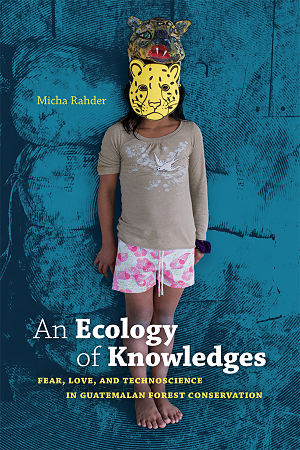Micha Rahder’s An Ecology of Knowledges: Fear, Love, and Technoscience in Guatemalan Forest Conservation is an ethnographically rich account of the dense conservation networks and politics that operate within the country’s Maya Biosphere Reserve. Hailed as a global “hot spot” for ecological research, the Maya Biosphere Reserve (MBR) has an undeniable presence in the world of scientific research, environmental NGOs, archeological and heritage sites, and conservation funding. The MBR is located in the northern region of the country, spread across twenty-one thousand square kilometers but divided by several national parks and hundreds of small towns. Rather than having a general set of conservation laws for the entire region, each national park and town reside under different conservation jurisdictions regarding ecological research, resource extraction, and human settlement.
As Rahder notes, this incongruity results in a spectrum of conservation laws based on geography, racial identity, and national politics.These spatial-legal tensions become the focus of her research.
Rather than limit her study to one conservation effort, town, or park within the reserve, Rahder broadens her scope of analysis to ask how the MBR functions as a “a coherent, bounded reserve object, beset by knowable, measurable problems” (26). Her insights are based on 18 months of fieldwork between the years 2007 and 2017, where she spent the majority of her time at CONAP (The National Council of Protected Areas) and the Guatemalan branch of the U.S. NGO the Wildlife Conservation Society (WCS). Through her work with these organizations, she also spent time with community members of the towns Paso Caballos, Uaxactún, and Carmelita, three differently populated towns within the reserve. These divisions in research locations across the reserve provides a comparative understanding of the operations behind both national and foreign conservation organizations, and the juxtaposition of livelihood experiences between mostly Q’eqchi Maya migrants and Peteneros. Detailing how these scientific, conservation, and cultural worlds collide, Rahder writes of a landscape that is often challenged by violence, scarcities, and disaster. Nevertheless, she demonstrates how actions out of love, fear, and paranoia effectuate conservation practices that respond to the everyday challenges of operating the MBR.
The structure of the book is not to be taken for granted. While Rahder theorizes ethnographic objects and intimacies, she is most talented at weaving a wide spectrum of ethnographic moments to illuminate a larger, book-length analytic. Her exhaustive notes on the work of scientists, organization administrators, and local community leaders are written across three sections, nine chapters, and more than a handful of vignettes. These vignettes, or what she calls “narrative vines,” are threaded through the text and “form spirals of meaning as they appear repeatedly at different points in the text, emphasizing the nonlinear relations between different sites and scales” (7). The composition of the book’s chapters follows suit. Rahder writes her chapters as patches, partialities, or fragments of a “knowledge ecology,” an epistemic framework she uses to “describe and incorporate a multiplicity of epistemic frameworks, like a snake eating its own tail.” (3). In tandem with the knowledge ecology emerges her concept of the “nooscape.” Extending from the word “noosphere”—used by natural scientists in the twentieth century to refer to a holistic, balanced, “emergent global mind”—the nooscape incorporates Marilyn Strathern’s theory of partial perspectives and is characterized as “situated lashes of ecological-knowledge-worlds-in-the-making, emergent phenomena based on relative and situated scalar processes of partial connection rather than nested part-whole relationships” (4).
While the knowledge ecology is an analytic framework that allows Rahder to write across many different epistemes, the nooscape is the interstitial space between epistemes that connects at once a variety of knowledges from different scales, times, and places. To be more precise, the nooscape is “patterns of collective thought and action that emerge from and fold back into the material-ecological worlds of northern Guatemala” (4).
This looping, self-devouring effect of the knowledge ecology and the nooscape is not lost on readers. At times it can even be disorienting. Knowingly so, Rahder leaves the reader with “some lingering uncertainty about how certain patches connect—or don’t” (156). Reading this book is thus to accept an invitation to participate in the disorientation of conservation life within the MBR. It is also to reflect on how knowing material and materializing knowledge are mutually constitutive.
An Ecology of Knowledges makes a significant contribution to the anthropology of conservation, the state, and Latin America. A wide range of anthropological researches observe how conservation projects often blame marginalized and disempowered people for environmental degradation and forcibly remove indigenous and poor communities from the land to be protected. In Guatemala particularly, anthropologists and geographers research how conservation projects in Petén utilize the military in order to enforce globalized conventions of conservation, such as burning down houses as a method for preventing the expansion of human settlements in forested areas (see, for example, Grandia 2010 and Ybarra 2017). Rahder does not ignore these realities. Instead, she builds off these studies to prioritize a detailed account of the relationship between conservation actors and local communities, as well as “push back against common critiques of conservation by addressing the ways that people working in conservation institutions (many of whom are themselves local) attempt to understand and reconcile multiple human needs with multiple environmental priorities” (8). This subject positioning results in an ethnography that admirably illustrates how decisions made behind institutional walls are influenced by their failures in their applied contexts. Scholars interested in Guatemala, and Latin America more broadly, will appreciate how Rahder situates the work of these environmental professionals within national democratic politics and the region’s growing emphasis on green security states (Mendoza 2018). This includes learning how conservation initiatives retain authority through a mutual dependency between NGOs and the state (Chapter 2), how funding and professional positions for conservation institutions are affected by presidential elections (Chapter 3), how assumptions about ethnicity and migration are quantified into population statistics and written into conservation policy (Chapter 5), and how sources of local livelihoods are repurposed as conservation initiatives (Chapter 7).
Unable to provide a chapter by chapter summary, I finish this review by explaining the three sections of the book:“Double Visions,” “Patchiness and Fragmentation,” and “Composing and Composting Knowledges.” In “Double Visions,” Rahder sets out to understand how scientific practice and paranoia work in tandem to produce environmental knowledge about the MBR. Particularly in chapter two, “Eye of the Storm,” she follows the work of CEMEC (Center for Monitoring and Evaluation), a CONAP affiliated environmental tracking center for the reserve. Located within a politically fraught climate, Rahder analyzes how the institution generates and evaluates “useful” and “objective” data about the reserve that promotes technoscientific neutrality but nevertheless draws from a range of personal and political speculations. Chapter three, “Mapping Gobernabilidad,” examines the implementation of “governability” in relation to the management of the MBR. Faced with violence, narcotics trafficking, and organized crime, conservation agents are forced to reckon with their contradictory reliance on the military in order to maintain authority and surveillance of the region. Rahder concludes that, “gobernabilidad indicators lead to a confusion of responses, a striving for control and clarity that only further reproduces violence and contradiction” (91).
The second section, “Patchiness and Fragmentation,” focuses on the breakdown of consensus and action between different parties who care for and live in the MBR. In particular, chapter six pays attention to the politics of allowing, sensing, and preventing fire. Fires are a common occurrence throughout the MBR. Their causes are differentiated as well as their meaning. For example, Rahder notes that fire has been used as an agricultural tool that allows campesinos to farm, as a violent military tactic known as scorched earth campaigns that burn down unwanted settlements and their belongings, and as a political tool of resistance and protest by marginalized communities. These implications of fire “shift and blur(the boundaries) between conservation and development, war and peace, forest and farm, success and failure, individual and institution” (184). The differing relations to fire prevent any consensus on how to manage their presence in the MBR.
The last section of the book, “Composing and Composting Knowledges” focuses on the insights gained from implementation of conservation projects. For example, chapter eight, “Wild Life,” deconstructs “the wild” and describes how “wild encounters arise in and between sensing and knowing bodies, and remain rooted always in the particular places they occur” (227). Rahder’s experiences with the wild take place through jungle excursions with veterinarians and research biologists to extract, feel, and see the “real” MBR. This results in two types of wild encounters that are contingent upon one another: 1. Encounters with wildlife and 2. Spontaneous and mind-blowing experiences, “as in a hippies declaration” (222). Placing camera traps in remote areas of the jungle and anecdotes of fieldwork experiences unveiled rare encounters with jaguars and macaws that were then turned into conservation data. Through these “wondrous” experiences, Rahder exposes how wild encounters are actually instigated and well-crafted, rather than spontaneous and unexpected, moments. Traps, experiments, and anecdotes become objects that politicize what is considered “wild,” “natural,” and “conservationist.”
After nine chapters and ten vignettes, the book concludes with a short afterword. What to do with all this information? Instead of situating her work within the larger discourse of environmental anthropology, Rahder ends the book with a personal note: “my own knowledges about the MBR are inseparable from the dynamics I describe throughout this book. This also means that my own attempts to transform something of this knowledge into usefulness is a patchwork of successes and failures, shifts and gaps” (266). Ending with this methodological reflection ensures that the nooscape does not remain archived on the reader’s bookshelf. Instead, this note pushes the reader to apply these same questions upon themselves as they continue to learn, build, and share knowledge across a multivalent yet fragmented world.
Grandia, Liza. 2012. Enclosed: Conservation, Cattle, and Commerce Among the Q’eqchi’ Maya Lowlanders. Seattle: University of Washington Press.
Mendoza, Marcos. 2018. The Patagonian Sublime: The Green Economy and Post-Neoliberal Politics. Rutgers University Press.
Ybarra, Megan. 2017. Green Wars: Conservation and Decolonization in the Maya Forest. University of California Press










